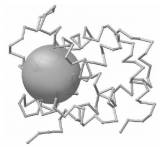|
Table of Contents
LFM-Pro: A Tool for Detecting Significant Local Structural Sites in Proteins
Motivation The rapidly growing protein structure repositories have opened up new opportunities for discovery and analysis of functional and evolutionary relationships among proteins. Detecting conserved structural sites that are unique to a protein family is of great value in identification of functionally important atoms and residues. Currently available methods are computationally expensive and fail to detect biologically significant local features. ResultsWe propose LFM-Pro (Local Feature Mining in Proteins) as a framework for automatically discovering family specific local sites and the features associated with these sites. Our method uses the distance field to backbone atoms to detect geometrically significant structural centers of the protein. A feature vector is generated from the geometrical and bio-chemical environment around these centers. These features are then scored using a statistical measure, for their ability to distinguish a family of proteins from a background set of unrelated proteins, and successful features are combined into a representative set for the protein family. The utility and success of LFM-Pro are demonstrated on Trypsin-like Serine Proteases family of proteins. The results verify that our method is successful both in identifying the distinctive sites of a given family of proteins, and in classifying proteins using the extracted features. AvailabilityThe software is freely available for academic research use. Contactahmet[at]ceng.metu.edu.tr , {ozturk,hakan,yusu}@cse.ohio-state.edu PublicationAhmet Sacan, Ozgur Ozturk, Hakan Ferhatosmanoglu, and Yusu Wang. LFM-Pro: A Tool for Detecting Significant Local Structural Sites in Proteins. Bioinformatics, 23(6):709-716, 2007 Datasets
Installationdownload and unzip the LFMPro software package into folder (The root folder will be denoted as “LFMPro” from here on). When unzipped, you should have the following folders:
Prerequisites
Quick-Run Guidein MATLAB:
>> globals_set;
>> rep = mine_family_represent(familyName, 'ptns',ptnNames, 'rand',backgroundPtns);
>> signatures_show(pdb, 'familyName',familyName)
For example: >> data_prepare_batch('help');
Sample TasksHere is a list of sample runs demonstrating some of the available functionality:
Function ReferenceSee the function reference page for the list of available functions and their usage. Extending LFMProYou can view the local features page if you wish to extend LFMPro to incorporate new local features. |




